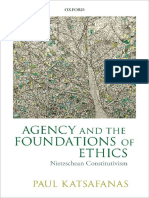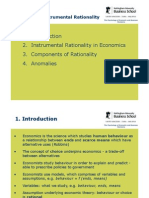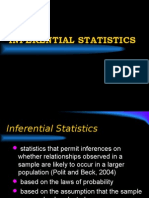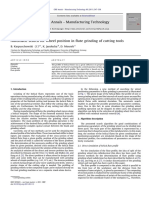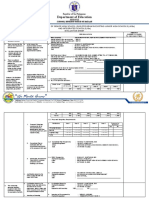100%(1)100% found this document useful (1 vote)
996 viewsPhenomenology
Phenomenology
Uploaded by
malyn1218This document discusses the application of phenomenology in nursing practice, education, and administration. It provides examples of phenomenological studies conducted in each of these areas. In nursing practice, one study explored the experiences of caring for family members with Alzheimer's disease. In education, a study examined technological competence as it relates to learning in critical care nursing. In administration, a study investigated nursing management from the perspectives of different stakeholders in a developing organization. The document emphasizes that phenomenology is well-suited for exploring subjective experiences in nursing.
Copyright:
Attribution Non-Commercial (BY-NC)
Available Formats
Download as PPT, PDF, TXT or read online from Scribd
Phenomenology
Phenomenology
Uploaded by
malyn1218100%(1)100% found this document useful (1 vote)
996 views24 pagesThis document discusses the application of phenomenology in nursing practice, education, and administration. It provides examples of phenomenological studies conducted in each of these areas. In nursing practice, one study explored the experiences of caring for family members with Alzheimer's disease. In education, a study examined technological competence as it relates to learning in critical care nursing. In administration, a study investigated nursing management from the perspectives of different stakeholders in a developing organization. The document emphasizes that phenomenology is well-suited for exploring subjective experiences in nursing.
Copyright
© Attribution Non-Commercial (BY-NC)
Available Formats
PPT, PDF, TXT or read online from Scribd
Share this document
Did you find this document useful?
Is this content inappropriate?
This document discusses the application of phenomenology in nursing practice, education, and administration. It provides examples of phenomenological studies conducted in each of these areas. In nursing practice, one study explored the experiences of caring for family members with Alzheimer's disease. In education, a study examined technological competence as it relates to learning in critical care nursing. In administration, a study investigated nursing management from the perspectives of different stakeholders in a developing organization. The document emphasizes that phenomenology is well-suited for exploring subjective experiences in nursing.
Copyright:
Attribution Non-Commercial (BY-NC)
Available Formats
Download as PPT, PDF, TXT or read online from Scribd
Download as ppt, pdf, or txt
100%(1)100% found this document useful (1 vote)
996 views24 pagesPhenomenology
Phenomenology
Uploaded by
malyn1218This document discusses the application of phenomenology in nursing practice, education, and administration. It provides examples of phenomenological studies conducted in each of these areas. In nursing practice, one study explored the experiences of caring for family members with Alzheimer's disease. In education, a study examined technological competence as it relates to learning in critical care nursing. In administration, a study investigated nursing management from the perspectives of different stakeholders in a developing organization. The document emphasizes that phenomenology is well-suited for exploring subjective experiences in nursing.
Copyright:
Attribution Non-Commercial (BY-NC)
Available Formats
Download as PPT, PDF, TXT or read online from Scribd
Download as ppt, pdf, or txt
You are on page 1of 24
REVIEW OF LITERATURE
The rationale for postponing
the literature review is related
to the goal of achieving a pure
description of the phenomenon
under the investigation.
TRUSTWORTHINESS AND
AUTHENTICITY OF DATA
Put to study participants depends
on the extent to which they tap
the participants’ experiences
apart from the participants’
theoretical knowledge of the
topic.
Consistent use of the method and
bracketing prior knowledge helps
to ensure pure description of
data.
TRUSTWORTHINESS AND
AUTHENTICITY OF DATA
Requesting negative
descriptions of the
phenomenon under
investigation is helpful in
establishing authenticity and
trustworthiness of the data
PHENOMENOLOGY IN
PRACTICE, EDUCATION &
ADMINISTRATION
Very often in nursing we are
faced with practice, education and
administrative experiences that
seem to present patterns that are
familiar to us. In order to validate
our perceptions research must be
conducted to explore and describe
the phenomenon fully and
accurately.
APPLICATION TO PRACTICE
Many nursing interventions
performed in clinical settings
lend themselves to quantitative
measurement.
Subjective phenomena unique to
the practice of professional
nursing need investigate
approaches suitable to their
unique nature.
APPLICATION TO PRACTICE
Phenomenology as a
qualitative research method
has been used to explore a
variety of practice-related
experiences and facilitates
understanding of subjective
interactive experiences.
APPLICATION TO PRACTICE
Nurse are in a prime position to
identify issues related to nursing
practice that need to be
understood and described more
fully.
Example: “The Experience of
Caring for a Family Member with
Alzheimer’s Disease” by Butcher
et al.
APPLICATION TO PRACTICE
Butcher et al. (2001) emphasize
the need for a qualitative
research design , noting that
“the bulk of ADRD family
caregiving research has been
conducted by means of surveys,
and closed-ended interview
methods that rely heavily on
standardized psychometric
instruments including
various depression and anxiety
scales, caregiver burden scales,
symptom checklists, and
structural diagnostic assessment
tool”
APPLICATION TO PRACTICE
‘One of the unique features of van
Kaam’s phenomenological
method is the reporting of
frequencies and percentages of the
participants for each of the
preliminary structural elements and
essential structural elements.
APPLICATION TO PRACTICE
Data analysis was described in
detail and followed the rigorous
research methodology described
by van Kaam. The steps of van
Kaam are used to clarify how
essential and preliminary
structural elements were
developed and percentages
calculated.
APPLICATION TO
EDUCATION
Nursing education also lends
itself to objective and subjective
research interests.
Test construction and critical
thinking are education – related
examples that are appropriate
for quantitaive investigation,
although not exclusively.
APPLICATION TO
EDUCATION
The educational domain of
nursing also lends itself to
qualitative investigation in areas
such as educational experiences,
caring and the curriculum, or the
effect of evaluation on student
performance in the clinical
setting.
APPLICATION TO
EDUCATION
Nursing education is an important
area of research that can be
studied using qualitative
approaches.
Example: “Technological
Competence as a Fundamental
Structure of Learning in Critical
Care Nursing: A Phenomenological
Study” by Little (2000)
APPLICATION TO
EDUCATION
Little (2000) described her
participant selection in detail.
Her selection process supported
a qualitative framework in that it
was purposeful, and subjects had
experience with the phenomenon
under investigation.
APPLICATION TO
EDUCATION
Little(2000) also addresses the
protection of human subjects
and she notes that ethical
principles were honored.
The data collection strategies use
by Little (2000) support
phenomenological approaches to
description, discovery, and
understanding.
APPLICATION TO
ADMINISRATION
There is limited literature on
studies related to nursing
administration that use
qualitative approaches.
APPLICATION TO
ADMINISRATION
The development of qualitative
research that describes
phenomena important to nursing
administration might include
research that examines
professional nurse behavior and
work satisfaction, successful
leadership strategies, and
perspective on nurse
empowerment.
APPLICATION TO
ADMINISRATION
Example study: “Management
from Four Different
Perspectives” by Lindholm,
Uden, and Rastam (1999) is
presented as an example of
the application of qualitative
research in the area of
administration.
APPLICATION TO
ADMINISRATION
The phenomenon of interest,
identified in the study,
focused on gaining an
understanding of the process
of nursing management in a
developing organization.
APPLICATION TO
ADMINISRATION
The purpose of the study was to
“illuminate nursing management in
a developing organization from the
perspectives of nurse managers,
chief physicians, hospital doctors
and politicians respectively”
(Lindholm et al., 1999). The
authors make explicit their
purpose and support it with a
review of the literature.
APPLICATION TO
ADMINISRATION
The sample included 15 nurse
managers, 11 chief physicians,
and three politicians who were
chairmen of the local health
boards. “The nurse managers
were all women, except for one.
In the other groups all the
participants were men”
(Lindholm et al, 1999)
APPLICATION TO
ADMINISRATION
The method used to collect data
was compatible with the research
purpose and adequately
addressed the phenomena of
interest.
The findings demonstrate the
participants’ realities and the
researchers relate the findings of
the study to what is already
known.
You might also like
- DST Final Exam NotesDocument56 pagesDST Final Exam NoteslmaoheartsNo ratings yet
- An Introduction To Fictional Worlds Theory) An Introduction To Fictional Worlds TheoryDocument107 pagesAn Introduction To Fictional Worlds Theory) An Introduction To Fictional Worlds TheoryAlexander Caro100% (1)
- Voyagers: Project Alpha (Book 1)Document44 pagesVoyagers: Project Alpha (Book 1)Random House Kids71% (7)
- Assignment 1: Pk30703 Career and PlacementDocument16 pagesAssignment 1: Pk30703 Career and PlacementLi JunNo ratings yet
- Affilia: Incorporating Spirituality in Feminist Social Work PerspectivesDocument20 pagesAffilia: Incorporating Spirituality in Feminist Social Work Perspectivesklau0dee0deeNo ratings yet
- Katsafanas P Agency Foundations of Ethics Nietzschean Constitutivism 13 PDFDocument280 pagesKatsafanas P Agency Foundations of Ethics Nietzschean Constitutivism 13 PDFFelipe Elizalde100% (1)
- Ethics After Idealism PDFDocument2 pagesEthics After Idealism PDFGustavoNo ratings yet
- Max Scheler's Phenomenology of ShameDocument11 pagesMax Scheler's Phenomenology of ShamemartinvouillozNo ratings yet
- Assessing The Skull and Face-WordDocument3 pagesAssessing The Skull and Face-Wordmalyn1218100% (1)
- Motivation Letter Sample For A PHD in BiotechnologyDocument8 pagesMotivation Letter Sample For A PHD in BiotechnologyDesyHyukkie Anchovy50% (4)
- A Permanent Struggle Against An Omnipresent Death - Revisiting Environmental Racism With Frantz Fanon-Romy Opperman 2019Document25 pagesA Permanent Struggle Against An Omnipresent Death - Revisiting Environmental Racism With Frantz Fanon-Romy Opperman 2019Oscar WindsNo ratings yet
- Race As The Primary Contradiction - Charles W MillsDocument4 pagesRace As The Primary Contradiction - Charles W MillsMezzeum100% (1)
- Mills - Critique of ShelbyDocument28 pagesMills - Critique of ShelbydrfergNo ratings yet
- Critical Discourse Analysis of Selected Political Campaign Speeches of GubeDocument218 pagesCritical Discourse Analysis of Selected Political Campaign Speeches of GubeTobi DavidNo ratings yet
- Diversity of EthnomethodologyDocument35 pagesDiversity of EthnomethodologyJac LibatiqueNo ratings yet
- Eliminate Racism Concept PaperDocument30 pagesEliminate Racism Concept PaperDaniel M100% (1)
- Husserl S Epoche and Phenomenological deDocument5 pagesHusserl S Epoche and Phenomenological deJohn O'sheaNo ratings yet
- Existential PhenomenologyDocument10 pagesExistential PhenomenologyJoel RedecioNo ratings yet
- TESIS Walklate The Metamorphosis of The Victim of Crime From Crime To Culture and The Implications For JusticeDocument13 pagesTESIS Walklate The Metamorphosis of The Victim of Crime From Crime To Culture and The Implications For JusticeKaty DiazNo ratings yet
- Feminist TechniquesDocument22 pagesFeminist TechniquesAmorsolo Espiritu100% (1)
- Society For The Study of Peace, Conflict, and ViolenceDocument14 pagesSociety For The Study of Peace, Conflict, and ViolenceJournal of International Relations DUNo ratings yet
- Soren Kierkegaard and ExistentialismDocument3 pagesSoren Kierkegaard and ExistentialismthemashaNo ratings yet
- AngeloDocument5 pagesAngeloRyan Cadorna Fontanilla100% (1)
- Care Ethics: Origins and Motivations: by Dr. Anumita ShuklaDocument6 pagesCare Ethics: Origins and Motivations: by Dr. Anumita ShuklaMayank Bora100% (1)
- Philosophy of Science II: From Positivists To Thomas KuhnDocument23 pagesPhilosophy of Science II: From Positivists To Thomas KuhnRiry AmbarsaryNo ratings yet
- Research MethodologyDocument32 pagesResearch Methodologymuneerpp80% (5)
- Price-2003-The Ethics of Authentic TransformatDocument15 pagesPrice-2003-The Ethics of Authentic Transformatjmalagon5568No ratings yet
- Kant RacistDocument17 pagesKant Racistsamuelito14100% (1)
- How Business Schools Lost Their Way: Group 3Document11 pagesHow Business Schools Lost Their Way: Group 3Anamika sharmaNo ratings yet
- 3 - Psychology in Relation To MedicineDocument23 pages3 - Psychology in Relation To MedicineZackNo ratings yet
- Mills - Philosophy and The Racial ContractDocument15 pagesMills - Philosophy and The Racial ContractElisaNo ratings yet
- Research Design Literature ReviewDocument10 pagesResearch Design Literature Reviewakesh30No ratings yet
- How To Be A Good ManDocument352 pagesHow To Be A Good ManFazil MannilNo ratings yet
- Watkins Et Al Humility 2019Document23 pagesWatkins Et Al Humility 2019Milo DueNo ratings yet
- Beginnings of Experimental PsychologyDocument39 pagesBeginnings of Experimental PsychologyROSANA RODRIGUEZ0% (1)
- Mixed Methods Research PDFDocument14 pagesMixed Methods Research PDFChin Ing KhangNo ratings yet
- Attribution Theory of Social PsychologyDocument3 pagesAttribution Theory of Social PsychologyDilip SirisenaNo ratings yet
- Structural MarxismDocument10 pagesStructural MarxismManasvi Mehta100% (1)
- Intuitionism and PhilosophyDocument15 pagesIntuitionism and Philosophyjimi2266No ratings yet
- Analyzing Qualitative DataDocument8 pagesAnalyzing Qualitative DataLilianaNo ratings yet
- Ethnography: AnthropologyDocument5 pagesEthnography: AnthropologyAdeel RazaNo ratings yet
- Different Philosophical Views of SelfDocument16 pagesDifferent Philosophical Views of SelfGermie Mariel GojarNo ratings yet
- Lecture 1 Instrumental RationalityDocument5 pagesLecture 1 Instrumental RationalitysozzledsquirrelNo ratings yet
- What Is Phenomenology?Document3 pagesWhat Is Phenomenology?bowbingNo ratings yet
- Interpretation and Objectivity: A Gadamerian Reevaluation of Max Weber's Social ScienceDocument12 pagesInterpretation and Objectivity: A Gadamerian Reevaluation of Max Weber's Social ScienceÀrabe CronusNo ratings yet
- (Lect03) - Logical EmpiricismDocument13 pages(Lect03) - Logical EmpiricismKai ErlenbuschNo ratings yet
- Prototype Theory and Meaning PDFDocument405 pagesPrototype Theory and Meaning PDFNaddiNo ratings yet
- Evolution of Management ThoughtDocument11 pagesEvolution of Management ThoughtbennybenhamNo ratings yet
- God Writes Straight With Crooked Lines - Levinas On Agape Without ErosDocument16 pagesGod Writes Straight With Crooked Lines - Levinas On Agape Without ErosChristian EspirituNo ratings yet
- Transtheoretical Model ReportDocument9 pagesTranstheoretical Model ReportRogelio Saupan JrNo ratings yet
- Davis, The Political Church and The Profane StateDocument270 pagesDavis, The Political Church and The Profane StateJohn100% (1)
- Personhood An Essential Characteristic of The Human SpeciesDocument25 pagesPersonhood An Essential Characteristic of The Human SpeciesHary KatawaNo ratings yet
- Ivana Marková - The Dialogical Mind - Common Sense and Ethics (2016, Cambridge Univertisy Press)Document257 pagesIvana Marková - The Dialogical Mind - Common Sense and Ethics (2016, Cambridge Univertisy Press)sugokkNo ratings yet
- Existential TheoryDocument12 pagesExistential Theorymanuelana100% (1)
- (Jonathan A. Smith) Qualitative PsychologyDocument22 pages(Jonathan A. Smith) Qualitative PsychologykonstantinosdietNo ratings yet
- A Systems Conception of PersonalityDocument40 pagesA Systems Conception of PersonalityDonNo ratings yet
- Lesson 05Document12 pagesLesson 05rajamsc2003No ratings yet
- Religion in The Making - Alfred North Whitehead - 1926Document40 pagesReligion in The Making - Alfred North Whitehead - 1926André Fogliano100% (1)
- Ethical ApproachesDocument4 pagesEthical ApproachesJustinNo ratings yet
- Maslow - Holistic Dynamic Theory PDFDocument6 pagesMaslow - Holistic Dynamic Theory PDFCynthia KautsaNo ratings yet
- The Evolution of Moral CognitionDocument237 pagesThe Evolution of Moral CognitionhermenericoNo ratings yet
- Essays On Pragmatic Naturalism: Discourse Relativity, Religion, Art, and EducationFrom EverandEssays On Pragmatic Naturalism: Discourse Relativity, Religion, Art, and EducationNo ratings yet
- NTGP-SJCS. Usefulness of Nursing Theory-Guided PracticeDocument16 pagesNTGP-SJCS. Usefulness of Nursing Theory-Guided PracticeMariana ValleNo ratings yet
- Cse New 1Document1 pageCse New 1malyn1218No ratings yet
- Generic Risk Assessment RegisterDocument28 pagesGeneric Risk Assessment Registermalyn1218No ratings yet
- Safety Alet GrindingDocument1 pageSafety Alet Grindingmalyn1218No ratings yet
- Quanti Research DesignDocument30 pagesQuanti Research Designmalyn1218100% (1)
- Accident TriangleDocument1 pageAccident Trianglemalyn1218No ratings yet
- Problem Formulation in Applied Social ResearchDocument6 pagesProblem Formulation in Applied Social Researchmalyn1218No ratings yet
- Probability SamplingDocument24 pagesProbability Samplingmalyn1218No ratings yet
- Power AnalysisDocument23 pagesPower Analysismalyn1218100% (1)
- Diesel Storage Tank Operational GuidelinesDocument8 pagesDiesel Storage Tank Operational Guidelinesmalyn1218No ratings yet
- Non Probability SamplingDocument11 pagesNon Probability Samplingmalyn1218No ratings yet
- Reliability of Measurement ToolsDocument6 pagesReliability of Measurement Toolsmalyn1218No ratings yet
- Inferential StatisticsDocument16 pagesInferential Statisticsmalyn1218100% (2)
- Power and PoliticsDocument18 pagesPower and Politicsmalyn1218100% (2)
- Data Collection MethodsDocument30 pagesData Collection Methodsmalyn121850% (2)
- Intro To ValidityDocument27 pagesIntro To Validitymalyn1218No ratings yet
- Methods of Data CollectionDocument44 pagesMethods of Data Collectionmalyn1218No ratings yet
- Therapeutic Communication TechniquesDocument10 pagesTherapeutic Communication Techniquesmalyn1218100% (4)
- Statistics Intro: Univariate Analysis Central Tendency DispersionDocument21 pagesStatistics Intro: Univariate Analysis Central Tendency Dispersionmalyn1218No ratings yet
- External ValidityDocument15 pagesExternal Validitymalyn1218No ratings yet
- Causal HypothesisDocument8 pagesCausal Hypothesismalyn1218100% (1)
- Experimental Research DesignsDocument4 pagesExperimental Research Designsmalyn1218No ratings yet
- Deductive Inductive ReasoningDocument10 pagesDeductive Inductive Reasoningmalyn1218No ratings yet
- EthicsDocument10 pagesEthicsmalyn1218No ratings yet
- Data Colection TypesDocument31 pagesData Colection Typesmalyn1218No ratings yet
- Data Analysis: Florenda F. Cabatit RN MA FacilitatorDocument44 pagesData Analysis: Florenda F. Cabatit RN MA Facilitatormalyn1218No ratings yet
- SkinDocument34 pagesSkinmalyn1218100% (2)
- The Communication ProcessDocument13 pagesThe Communication Processmalyn1218No ratings yet
- Nutrition Powerpoint NewDocument74 pagesNutrition Powerpoint Newmalyn121888% (8)
- Physical AssessmentDocument12 pagesPhysical Assessmentmalyn1218No ratings yet
- Ul Certificate Latest-23Document2 pagesUl Certificate Latest-23ekramul.haqueNo ratings yet
- T Ulangan 1 2 3 4 T0 T1 T2 T3 T4: One-Way ANOVA: Hasil Versus PerlakuanDocument3 pagesT Ulangan 1 2 3 4 T0 T1 T2 T3 T4: One-Way ANOVA: Hasil Versus PerlakuanMauludinNo ratings yet
- CV-1 PHDocument27 pagesCV-1 PHaya najemNo ratings yet
- Introduction To Educational Research 1st Edition Mertler Test Bank 1Document36 pagesIntroduction To Educational Research 1st Edition Mertler Test Bank 1karenholmesgmzfxtpacw100% (45)
- Process PortfolioDocument27 pagesProcess Portfolioapi-534106049No ratings yet
- Development of Application Guidance On Equipment Validation of Analytical InstrumentsDocument12 pagesDevelopment of Application Guidance On Equipment Validation of Analytical InstrumentsAntonio MeloNo ratings yet
- Research Report of China Jewelry MarketDocument7 pagesResearch Report of China Jewelry Marketgiveme51021No ratings yet
- Njana Drishti 01Document2 pagesNjana Drishti 01ajithinjames007No ratings yet
- Green Synthesis of Iron and Zinc Oxide Nanoparticles From Moringaoleiferapod Peel Extract and In-Vitro Analysis of Their Antibacterial PotentialDocument9 pagesGreen Synthesis of Iron and Zinc Oxide Nanoparticles From Moringaoleiferapod Peel Extract and In-Vitro Analysis of Their Antibacterial PotentialIJAR JOURNAL100% (1)
- Feasibility Study 2013Document6 pagesFeasibility Study 2013John Morrel D. MirandaNo ratings yet
- PDF Money, Banking and Financial Markets, 6e ISE Stephen G. Cecchetti downloadDocument21 pagesPDF Money, Banking and Financial Markets, 6e ISE Stephen G. Cecchetti downloadradhakocikpk100% (3)
- Automatic Search For Wheel Position in Flute Grinding of Cutting ToolsDocument4 pagesAutomatic Search For Wheel Position in Flute Grinding of Cutting ToolsGustavo FerronattoNo ratings yet
- Lynn Brooks Womens Work Making Dance in Europe Before 1800 PDFDocument282 pagesLynn Brooks Womens Work Making Dance in Europe Before 1800 PDFMariela PuglieseNo ratings yet
- Refresher ProbSet4Document15 pagesRefresher ProbSet4Ellen Mae PrincipeNo ratings yet
- DLL_MAPEH 4_Q3 W5 FINALDocument11 pagesDLL_MAPEH 4_Q3 W5 FINALSamuel LetanaNo ratings yet
- Topic 32 AvuDocument5 pagesTopic 32 Avusonia_cabelloNo ratings yet
- Saddam ShaikhDocument1 pageSaddam ShaikhSaddam ShaikhNo ratings yet
- PhIMO 2023 Heat - PH RESULTSDocument41 pagesPhIMO 2023 Heat - PH RESULTSRalph ShinNo ratings yet
- Final Presentation (BSNL)Document22 pagesFinal Presentation (BSNL)ravikumar89386No ratings yet
- SHS Application ChecklistDocument5 pagesSHS Application Checklistronald bantugan100% (1)
- CS311 Introduction To Database Systems: Usman Institute of Technology Department of Computer ScienceDocument10 pagesCS311 Introduction To Database Systems: Usman Institute of Technology Department of Computer Scienceمحمد احمدNo ratings yet
- Impromptu Speech AssignmentDocument3 pagesImpromptu Speech AssignmentAprildiema SarimNo ratings yet
- Test de Evaluare Initiala Limba Engleza Clasa A Vii-A L1 ANUL SCOLAR 2017-2018Document2 pagesTest de Evaluare Initiala Limba Engleza Clasa A Vii-A L1 ANUL SCOLAR 2017-2018emiliaNo ratings yet
- Assignment No 2 Production TheoryDocument2 pagesAssignment No 2 Production TheoryCami Kmyutza0% (2)
- Mental Health Medications For Children - Fact Sheets - Yale MedicineDocument5 pagesMental Health Medications For Children - Fact Sheets - Yale MedicinewaleskacrzNo ratings yet
- Keshav Mini Project 2. Doc..... Docx Himcs....Document21 pagesKeshav Mini Project 2. Doc..... Docx Himcs....Luv SinghNo ratings yet
- Religious Delusions and The Limits of Spirituality in Decision-MakingDocument3 pagesReligious Delusions and The Limits of Spirituality in Decision-MakingTrismegisteNo ratings yet





